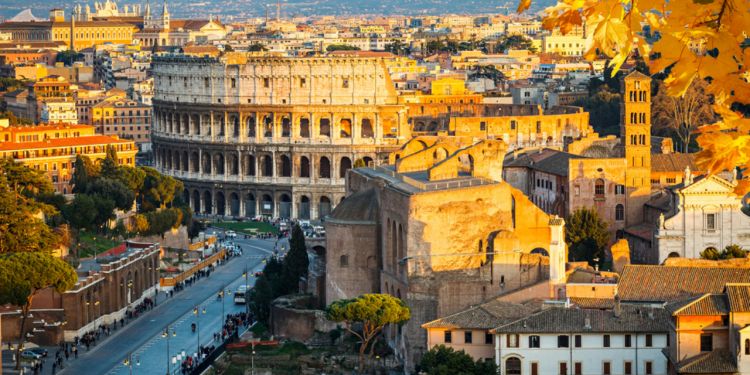Discover Rome

Rome is the capital of Italy and one of the country's most important cultural and tourist centers. It is also, to this day, the third most important tourist destination in Europe. Apart from its famous archaeological sites and museums, Rome is a complex city that you need to know about before you move there.
Geography and History of Rome
Rome, the main city of the Lazio region, is the most populous city in Italy and one of the largest on the European continent, with almost 3 million inhabitants living in its 1,287 km². In total, the city of Rome has more than 4 million inhabitants.
The capital was founded by Romulus in 753 BC and was, of course, the focal point of the Roman Empire. Remains of its grandeur can still be seen, such as the Colosseum and the well-preserved Roman Forum, which, together with the Vatican, symbolize Rome. The city is also considered an open-air museum thanks to its bridges, fountains and 900 churches that can be visited free of charge.
The historic center is built on seven hills. Rome is known as the "City of Seven Hills", the "Eternal City", and "Caput mundi" in Latin (Capital of the World).
These hills, some of which give their name to districts, are called :
- The Aventine (Italian: Aventino)
- The Caelius (Italian: Celio)
- The Capitol (Italian: Campidoglio)
- The Esquiline (Italian: Esquilino)
- The Palatine (Italian: Palatino)
- The Quirinal (Italian: Quirinale)
- The Viminale (Italian: Viminale)
Two hills are added to it: The Janiculum (Gianicolo) and the Pincio.
Climate and Nature in Rome
Rome is located at the mouth of the Tiber and has a Mediterranean climate: winter is mild. However, very cold days with temperatures close to zero can occur in December, January and February. Summer is hot and dry, with temperatures that can reach 40°C. Rain is not very frequent, with certain times of the year more likely to occur in autumn and spring, and in summer, it is not uncommon for a thunderstorm to break out.
The city is located close to the Tyrrhenian Sea but also to the mountains, the Apennines. This makes it an ideal city to enjoy the various leisure activities in and outside Rome and the beaches in summer. Rome can boast of being one of the greenest capitals in Europe with its parks located in the city center, such as Villa Doria Pamphili, Villa Ada, Villa Borghese and the Pincio Gardens or Villa Torlonia, but also its numerous regional parks and nature reserves.
To name a few:
- The Appia Antica Regional Park,
- The Monte Mario nature reserve,
- The Pineto urban regional park,
- The State Nature Reserve of the Roman Coast, the largest, covers 16,327 hectares. This abundant nature is home to around 145 species of animals.
Economy and Cost of living in Rome
Despite its proven tourist status, the city's economic situation is not the most flourishing and has even tended to decline in recent years, mainly due to its poor management. In Italy, the economic capital is Milan, not Rome. Despite this, there are major headquarters of international organizations such as the FAO (Food and Agriculture Organisation) and the IFAD (International Fund for Agricultural Development). It should be noted that the technological and pharmaceutical sectors are increasingly developing in the region.
The cost of living in Rome is similar to that of other European capitals, with a slight difference in the prices charged in certain bars and restaurants, depending on the area, where it is possible to eat for a more than reasonable price.
Social life in Rome
Romans are considered friendly and welcoming, which is true. However, you should be aware that you will need to have a fair knowledge of Italian to be able to interact. Indeed, Romans have poor language skills, although they will make efforts to facilitate communication.
As Rome is a welcoming city for expatriates from all over the world, it is not difficult to meet people of the same nationality as you. In addition, aperitifs are organized to exchange ideas, some of which are intended for people who want to learn languages: Tandem. If you are an international student in Rome, especially an Erasmus student, evenings and activities are often organized.
Getting around Rome
Rome has three metro lines: A, B, and C, which is still under construction and currently connects San Giovanni to the east of the city. However, there are also bus and tram lines, as well as urban trains to get around the city. It is advisable to check your itinerary before taking public transport in Rome. Note that due to the chaotic management of the urban transport company, some buses and trams do not run at fixed times. Season tickets are available on a monthly or annual basis. For more information, you can visit the official ATAC website.
Apart from Roman public transport, it is possible to rent a scooter or a car from various agencies. Bike and car-sharing services are also available. You will need to download the application and register in order to use them. However, traffic is heavy, and parking spaces are difficult to find in Rome.








